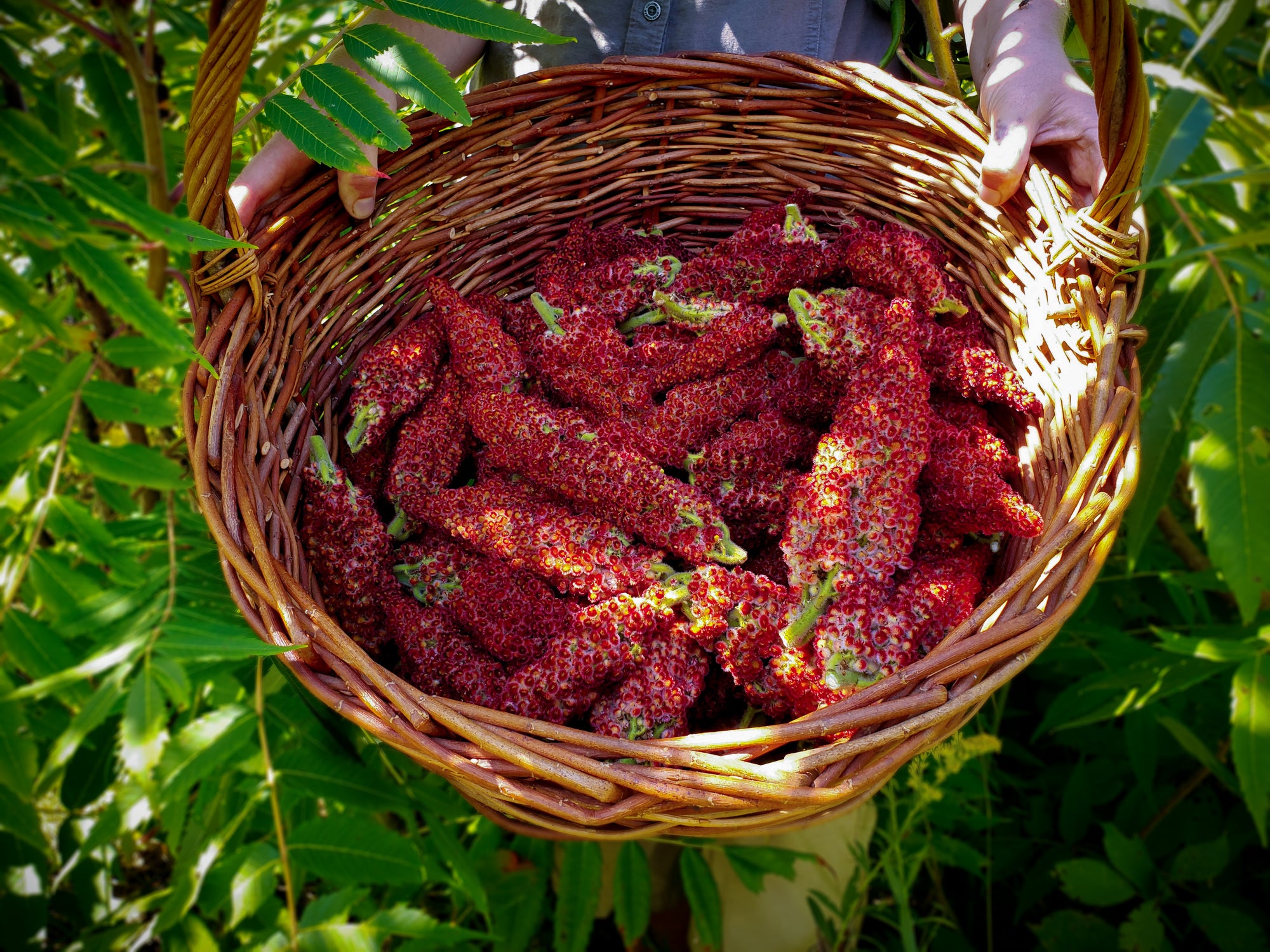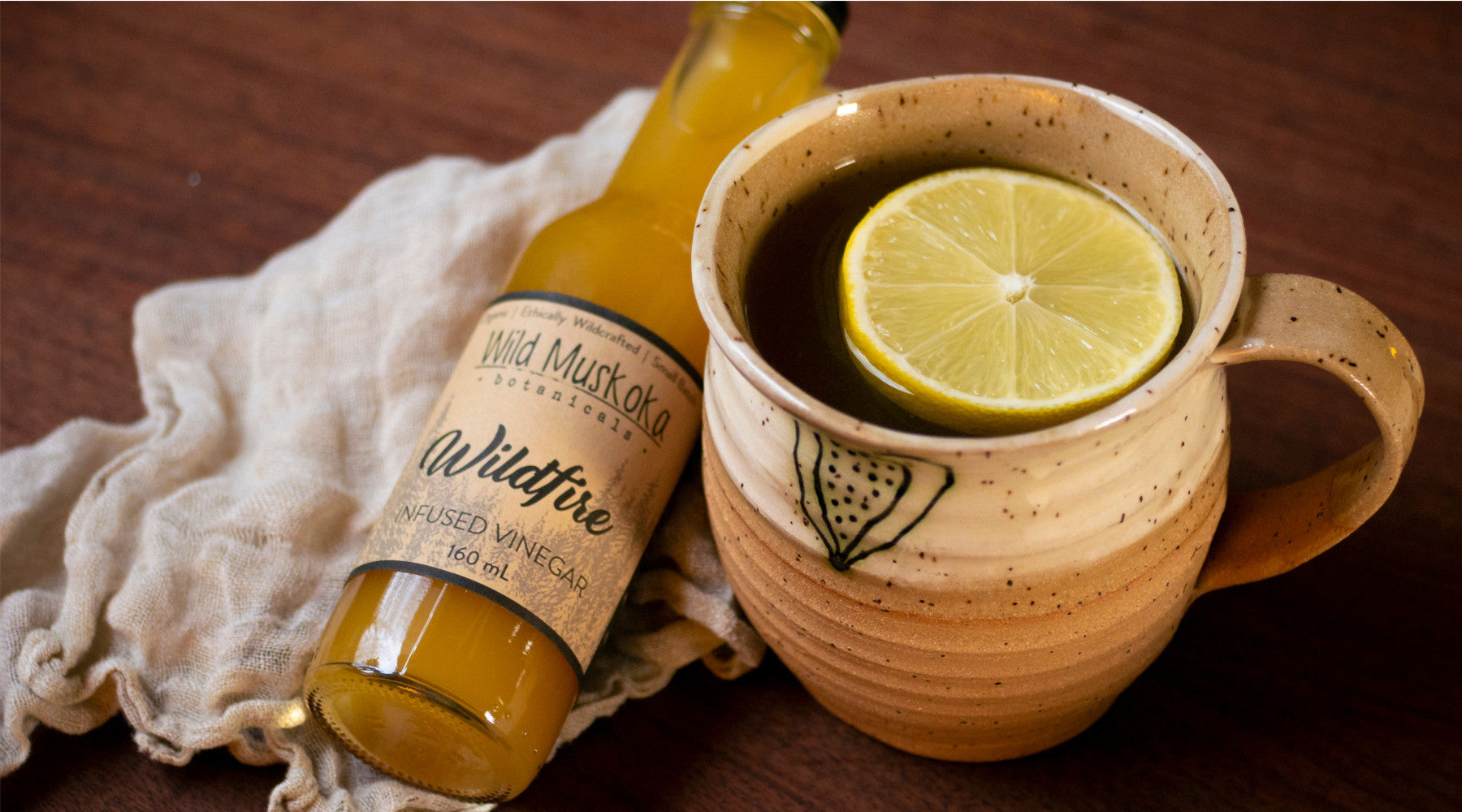
Have you ever tasted edible Sumac in a drink or dish?
In this article, we will share:
- Some of our favourite recipes that use Sumac in food and drinks.
- What you need to know if you would like to wild forage Sumac safely and sustainably.
The red fuzzy berries of Staghorn Sumac (Rhus typhina) have a tangy and slightly sour flavour that can be integrated into all kinds of fun artisan drinks and meals. We often refer to it as our Northern Lemon!
If you missed the short foraging season or would rather skip right to making the food and drinks, check out our made-for-you Sumac products, including:
- Wild Muskoka Za’atar Spice,
- Sumac Infused Vinegar (great on salads and stir-fries),
- Strawberry & Sumac Shrub drink mixer.
Foraging Edible Sumac: A Step-by-Step Guide
The vibrant red berries of SumacSumac are quite popular in Middle Eastern and Mediterranean cuisine. Many people do not realize that SumacSumac can be foraged from the wild in many parts of North America and used to create various delicious recipes.
We are big believers in bio-regionalism and supporting local food systems. Sumac is a native plant that gives a similar sour flavour to lemon. Thus, we have been able to replace the imported lemon with locally foraged Sumac in some recipes, such as our sumac lemonade recipe below.
1. Identifying Edible Sumac
The edible Sumac comes from the genus Rhus, and the most common type around us is Rhus typhina (Staghorn Sumac).
These shrubs are easily recognized by their bright red, cone-shaped clusters of berries, which are covered in fine, velvety hairs. The leaves are pinnate with up to 31 leaflets, and the plants are typically found in open, sunny areas such as fields, roadsides, and forest edges.

You may have heard of poison sumac before as well. Poison Sumac is in the genus Toxicodendron and is closely related to Poison Ivy and Poison Oak. We use the Staghorn Sumac berries in the recipes below; they are easily distinguishable from other varities.
Poison Sumac has clusters of large creamy green turning white berries as opposed to the much smaller and dense fuzzy red ones of Staghorn Sumac. Poison Sumac also prefers to grow in wet soil, while the Staghorn prefers dry, often disturbed soil.

Poison Sumac Photo Credit: Sammy Tangir
2. When to Forage Sumac
Here in the North Eastern Woodlands, the best time to forage Sumac is mid-summer (late July to early August), when the berries are deep red.
We always taste the berries first to see if they have a tinge of sourness yet. You may be too early if the berries are bright red but do not taste sour. We also pull the berries apart to look at the stem for signs of insects. There is often a short window between when they start to sour and when the insides show signs of insects.
Avoid Sumac that looks brownish or moldy, has black spots, or has an excess of insect signs.
3. How to Forage Sumac
To forage Staghorn Sumac, we bring large bags and a set of garden pruners and often wear gloves if we harvest a lot. This is to avoid getting too much of the sticky white sap on our hands. Interestingly enough, I (Chris) have a mild skin reaction to it (it goes away quickly after washing my hands), but it does not irritate Laura, who often picks it without gloves.
We cut the stem below the red clusters into our foraging bag from there.

4. Sustainability & Sumac's Ecological Role
As with anything we wild forage, it is essential to learn about the ecology of the plants we work with and respect their role in the greater ecosystem beyond just food and medicine for us two-legged.
Sumac is often a primary succession species in disturbed landscapes. This means it is one of the earlier shrubs to start growing, helping to heal the soil and lay the foundations for the land to transition back into native forest.
Many wildlife species also enjoy edible Sumac. Turkeys and many songbirds love the berries, and rabbits and rodents such as voles eat the cambium layer of the bark.
We should always leave lots of berries behind for the wildlife. When we finish foraging from a patch and look back at it, there is always lots of red left.
Be sure to leave some clusters behind to allow the plant to regenerate and to provide food for wildlife.
5. Using Sumac, How to Prepare it
Once foraged, they can be used fresh in recipes such as Sumac lemonade (see below), dried on a screen in a warm, well-ventilated area for storage or frozen to use later. We find that using a comb helps to remove the berries from the stem.
Cooking with Edible Sumac: Recipes that Use Sumac
Sumac’s tangy, lemony flavour makes it a fantastic addition to many dishes. Here are some of our favourite ways to use Sumac to craft delicious artisan foodie dishes:
1. Sumac Infused Apple Cider Vinegar
This is one of our favourite ways to preserve the flavour of Sumac and make it easy to integrate into salads, stir-fries and other dishes year-round.
We make an infused apple cider vinegar by filling a jar with Sumac, covering it with organic apple cider vinegar and letting it steep for a few weeks. We then strain out the fuzzy berries and bottle up the vinegar.
If you would like to avoid all the processing work and skip right to the delicous food, our Wild Muskoka Sumac Infused Vinegar can be ordered online here.
Purchasing our sustainably foraged Wild Muskoka products also helps support all our free offerings, such as this article and recipes.
2. Foraged Sumac & Wild Blueberry Jam Salad Dressing
This super quick salad dressing recipe is sure to impress your guests.
We love adding it to a fresh summer garden salad with some wild foraged leaves and flowers, as shown in the video below. But it tastes great on most store-bought salad greens and veggies, such as cucumbers, tomatoes, red onions, feta cheese, etc.
- 2 Tbls of wild Blueberry Jam (You can substitute your favourite berry jam)
- 2 Tbls of Sumac Infused Vinegar (made with apple cider vinegar)
- 1 Tbls of Olive Oil
- Stir and drizzle fresh on your favourite salad greens.
3. Sumac Za’atar Spice
Za’atar is a Middle Eastern and Mediterranean spice with a lot of history and regional variations. If you are curious about Za’atar’s uses, we share a few good ones below.
You can make your own Za’atar by combining:
- 1 Tbsp sumac powder
- 1 Tbsp toasted sesame seeds
- 1 tsp dried parsley
- 1 tsp dried oregano
- 1 tsp dried thyme
- ¼ tsp salt
Again, if you’d like to save on the work and skip right to the food and are looking for where to buy Za’atar Spice, our Wild Muskoka Za’atar is available online here.
4. Za’atar Uses:
4a. Tomato, Cucumber & Sumac Greek Salad
- 1 cucumber, cubed
- 1 small container of grape tomatoes
- (289 g), halved
- ¼ cup chopped red onion
- 100 g feta cheese, cubed
- ¼ cup black olives, chopped
- ¼ cup olive oil
- 2 Tbsp Muskoka Za’atar spice mix
4.b. Goat Cheese Rolled in Sumac Spice Recipe
This is a quick-to-make appetizer recipe that uses Sumac.
Ingredients:
- Roll or ball of Goat Cheese
- Wild Muskoka Za’atar spice

Instructions:
- Put 1 - 2 tablespoons of Za’atar on a small plate.
- Roll the Goat Cheese in the Za’atar
- Serve with your favourite crackers as an appetizer or part of a Charcuterie board.
4.c. Warm Za’atar on Naan Bread
This warming, melt-in-your-mouth dish is another one of our top Za’atar recipes when we are looking to entertain friends or have a nice warming appetizer.
Ingredients:
- Fresh Naan Bread
- Olive Oil
- Wild Muskoka Za’atar Spice
Instructions:
- Warm your oven to 250 degrees Ferenheight
- Drizzle a 1/2 tsp of olive oil over a piece of Naan. (Make as many as you want/need)
- Sprinkle Za’atar on top of the Naan to taste.
- Warm in the oven for 5minutes
- Eat warm!
Make a Sumac Drink: Refreshing Drinks with Edible Sumac
Sumac isn’t just for cooking—it also makes delicious and refreshing drinks. We use it to create healthy, cool drinks for hot afternoons, fancy cocktails, and mocktails for the non-drinkers at the party.
1. Sumac "No-Lemon" Lemonade Recipe
Sumac lemonade is a tangy, slightly sour and refreshing drink that’s perfect for summer and does NOT uses lemons.
Thus, it is a bioregional and more environmentally responsible way to enjoy a lemonade-like drink.

Instructions:
- Scrape the Staghorn Sumac berries off the branch with a fork.
- Fill a 1-litre mason jar (or whatever size jar you want to make) halfway with the berries.
- Important: Fill the jar with cold water. Using hot water will make the drink more bitter.
- Let it steep for 12 - 24-hours at room temperature or in the sun.
- Strain the liquid through a fine mesh sieve or cheesecloth to remove the berries and any debris.
- Sweeten the sumac water with honey or maple syrup to taste, and serve over ice.
2. Strawberry Sumac Shrub Cocktail or Mocktail with a Spruce Tip Sugar Rim
Some of our friends have coined this the “drink of the summer.” It’s a fun option for a hot summer afternoon or evening.
It can be made into a cocktail or left alcohol-free for kids and those who prefer a zero-proof mocktail but still want a fancy drink.
The full recipe instructions and how to make the wild foraged spruce sugar rum are on our Wild Muskoka YouTube channel.
Where to Buy Za’atar Spice & Where to Buy Sumac Infused Vinegar & Shrubs
By purchasing products through our online Wild Muskoka store,, you are supporting free articles and lessons such as this, and as helping keep small businesses and bio-regional food alive. Your support is much appreciated.
We sell the following products with sustainably wild foraged Sumac in them:
- Wild Muskoka Za’atar Spice,
- Sumac Infused Vinegar (great on salads and stir-fries),
- Strawberry & Sumac Shrub drink mixer.

Final Thoughts
Wild foraging for edible Sumac is a nourishing way to connect with nature, bring a unique, tangy sour flavour into your kitchen and reduce your environmental impact by working with local ingredients instead of importing lemons.
Whether making a salad or appetizer or mixing refreshing drinks, many Sumac uses make it a versatile ingredient that can elevate a wide range of recipes.
Next time you’re out in the wild, keep a watch for its vibrant red fuzzy berries and enjoy the many culinary possibilities. Just make sure to leave some for the Turkey's!
Happy Foraging!





